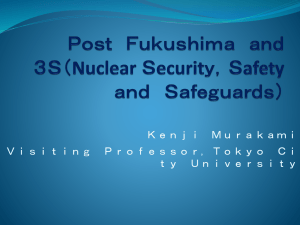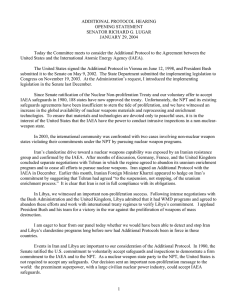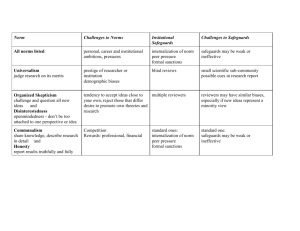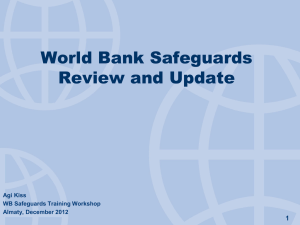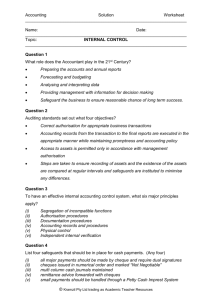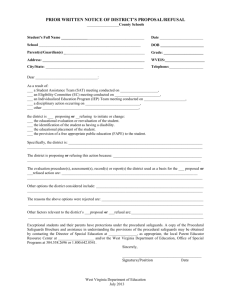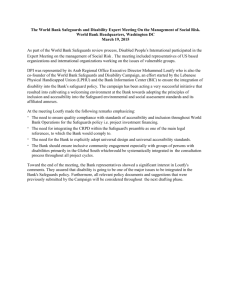Nonproliferation, Safeguards, and Export Controls
advertisement
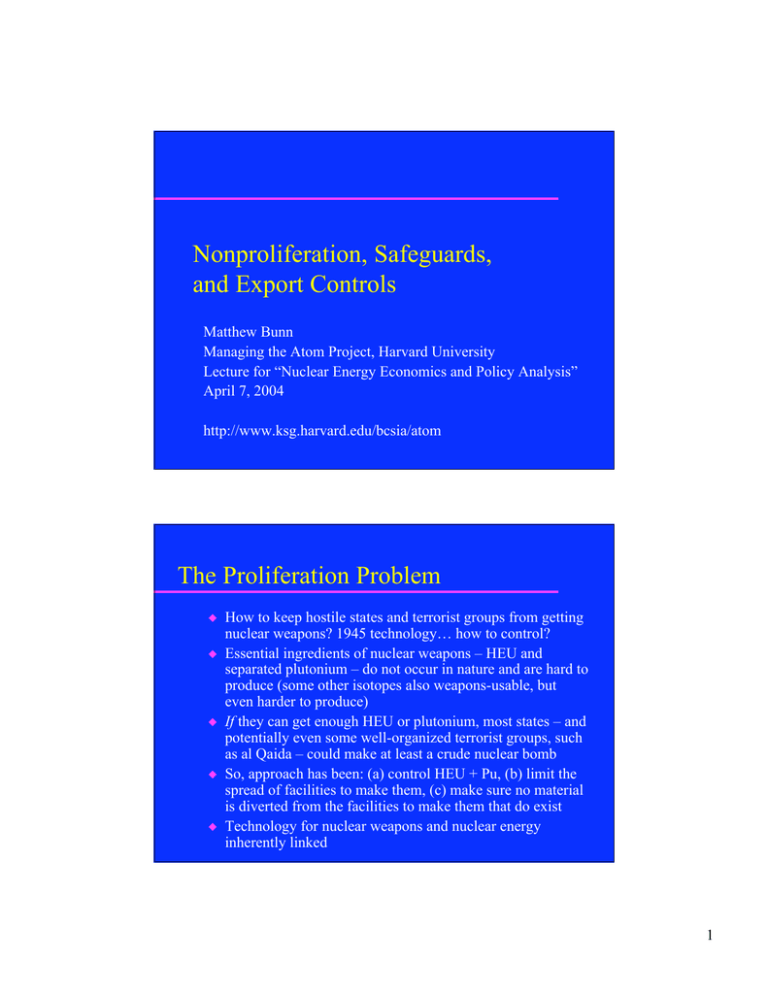
Nonproliferation, Safeguards, and Export Controls Matthew Bunn Managing the Atom Project, Harvard University Lecture for “Nuclear Energy Economics and Policy Analysis” April 7, 2004 http://www.ksg.harvard.edu/bcsia/atom The Proliferation Problem u u u u u How to keep hostile states and terrorist groups from getting nuclear weapons? 1945 technology… how to control? Essential ingredients of nuclear weapons – HEU and separated plutonium – do not occur in nature and are hard to produce (some other isotopes also weapons-usable, but even harder to produce) If they can get enough HEU or plutonium, most states – and potentially even some well-organized terrorist groups, such as al Qaida – could make at least a crude nuclear bomb So, approach has been: (a) control HEU + Pu, (b) limit the spread of facilities to make them, (c) make sure no material is diverted from the facilities to make them that do exist Technology for nuclear weapons and nuclear energy inherently linked 1 The Nonproliferation Regime u u u Global effort to stem the spread of nuclear weapons -including limiting civilian nuclear energy’s contribution to weapons Combines political measures (designed to reduce demand for nuclear weapons) and technical measures (designed to restrict supply of nuclear weapons materials and technologies) Surprisingly successful: rather than many dozens of nuclear weapons powers predicted by now, only 8-9 -- many more states have started weapons programs and then backed away than now have nuclear weapons. Dozens of states have the capability to produce nuclear weapons but have verifiably committed not to do so The Nuclear Nonproliferation Treaty u u u u Nearly 190 parties Essentially all countries except India, Pakistan, and Israel are parties to the NPT or comparable commitments 5 accepted weapon states: U.S., Russia, France, UK, China Basic provisions: – Non-nuclear-weapon states agree not to acquire nuclear weapons and to accept IAEA safeguards on all their civilian nuclear activities – Nuclear-weapon states agree not to provide nuclear weapons technology to non-nuclear-weapon states, and to negotiate in good faith toward disarmament – All parties to cooperate in the peaceful use of nuclear energy u Now under substantial stress – North Korean withdrawal, AQ Khan global black-market network, Iranian exploitation of loopholes – but unlikely to collapse 2 Categories of Proliferation Threats u Technically sophisticated states (e.g., India, Israel) Have the technology to produce fissile material, fission weapons; safeguards can detect diversion of material, construction of secret facilities (maybe), political measures can help reduce demand for weapons u Less sophisticated states (e.g., Iraq, North Korea) Technology controls can add substantial time and cost to efforts to produce weapons materials; stolen nuclear material could greatly accelerate acquisition of 1st bomb; other measures as above u Subnational groups (e.g., Aum Shinrikyo, Al Qaeda) Conceivable could produce crude but effective explosives if they acquired fissile material (esp. HEU), or could sell stolen material to a state -- risk of theft of nuclear material 5 Paths to the Bomb u No non-weapons obligation, material produced in dedicated military facilities with no safeguards – All 5 NPT weapon states, India, Pakistan, Israel (though some nonverified peaceful use assurances in latter cases) u Join NPT, accept safeguards, build needed facilities, then withdraw and expel inspectors – N. Korea (sort of -- never had full safeguards) -- Iran in the future? u Join NPT, accept safeguards, divert material from declared, safeguarded facility – This is only path traditional IAEA safeguards designed to detect u Join NPT, accept safeguards, build covert facilities – Iraq, N. Korea (U program) -- Iran??? – Additional Protocol designed to help detect u Purchase or steal weapon or weapon material 3 IAEA Safeguards u u u u u 1100 nuclear installations in >70 states, thousands of tons of material (>123,000 significant quantities) under safeguards 10,000 person-days of inspection/yr, ~$90M IAEA safeguards budget (same as Indianopolis police department) Designed to detect diversion of material for weapons -cannot prevent the state, or subnational parties, from removing material for weapons Primarily implemented in non-nuclear-weapon states; a few facilities in weapon states under “voluntary offer”; some facilities in non-NPT states safeguarded when supplier required it NPT member states have repeatedly expressed confidence that IAEA safeguards verify states are complying Traditional Safeguards u u Traditional safeguards use “material accountancy” and “containment and surveillance” to provide timely detection of diversion of significant quantities of nuclear material, and to deter such diversion by the risk of detection Significant quantities: – Pu or U233: 8 kg – HEU: 25 kg contained U-235 – Bombs can be made with less -- a key issue u Timeliness goal: – 1 month for unirradiated Pu or HEU (incl. MOX) u Traditional safeguards focus almost exclusively on detecting diversion from declared facilities – not on finding secret facilities 4 Traditional Safeguards (II) u u u INFCIRC/153 -- traditional safeguards agreement -negotiated at a time when nuclear energy expected to be crucial to national economies, non-nuclear-weapon states concerned to prevent safeguards from interfering, or offering commercial advantage to weapon states INFCIRC/153 -- limits IAEA to “minimum” info “consistent with carrying out its responsibilities” -verification mainly limited to few “strategic points” in declared facilities Result: IAEA inspectors’ culture of not asking too many questions, not being aggressive investigators (overgeneralization -- contrary cases exist, such as Taiwan) Material Accountancy MUF (Material Unaccounted For) = Beginning inventory + Additions to inventory - Ending inventory - Removals from inventory u s2MUF -- standard deviation of MUF -- is measurement precision u If MUF > than some threshold level -- usually 3 s2MUF -IAEA rejects the hypothesis that real MUF is zero, investigates possibility that diversion has occurred u For item facility (e.g., LWR), MUF=0 unless something is missing 5 Material Accountancy (II) Tools of Material Accountancy u u Destructive Analysis – Take a chemical sample of the material to laboratory for analysis. Highly accurate, but expensive and long delays. Non-Destructive Analysis (NDA) – Measure content of nuclear material by measuring gamma and neutron spectra (or other properties) using portable or on-site equipment. Less accurate (typically), but far more convenient. DA can be used to calibrate and confirm the accuracy of NDA equipment. International Accountancy Standards Facility Type Uranium enrichment Uranium fabrication Plutonium reprocessing Plutonium fabrication Scrap store Waste store Relative STD (%) 0.2 0.3 1.0 0.5 4.0 25.0 6 Containment and Surveillance u u Containment and surveillance complements material accountancy by (a) detecting unusual activities, (b) confirming there has been no removal of material from measured, sealed containers Typical measures include: – Surveillance cameras – Tamper-resistant seals (which will be broken if sealed item is opened) – Tamper-resistant tags (uniquely identify particular measured items) u u What happens when cameras go out, seals break? Often, re-inspection required Clearly, containment and surveillance contribute to safeguards confidence – but no one has come up with a way to measure how much better accountancy is with containment and surveillance added Accountancy and Inspection u Like bank auditor, inspectors don’t actually count all the money (measure all the material). Instead: – examine records provided by operator – inspect statistical samples of total quantity of material (based on the risk of the diversion they are attempting to detect) to build confidence records are accurate – in modern, automated facilities, often rely on in-line measurement equipment built by the operator -- premium on validating that measurements are accurate and unbiased – inspector must be able to make independent judgment -- not simply believe what the operator says u Difference between inspector’s measurements and operator’s measurements is MUF-D 7 4 Diversion Paths u u u u Diversion into MUF: “Gee, we can’t figure out where that missing material went” (no attempt to falsify records) Diversion into MUF-D: “Gee, I don’t know why your measurements show less than mine do” (typically would require falsifying operators accountancy records) Diversion with faking/tampering: “Gee, I hope they don’t notice that we added more plutonium to their solution samples to make our Pu concentrations look higher” Diversion with safeguards plausibly disrupted: “Gee, when we had that fire, our records were destroyed, and the firefighters threw out a bunch of contaminated material -that must be where that plutonium went.” Designing Inspections u u u u u First, envision ways material might be diverted from facility to be inspected -- including possibilities for faking/tampering Second, envision inspection approaches that might be able to detect those diversion scenarios Third, assess required detection probability, based on risk associated with the particular diversion scenario (e.g., low probability sufficient for detecting diversion of natural U, high probability needed for detecting Pu diversion) Fourth, design intensity of inspection (e.g., frequency, fraction of materials to be sampled, etc.) to provide detection capability commensurate with risk In reality: Large number of budget, practicality, political factors enter into picture 8 Diversion Scenarios: LEU LWR u State might remove fresh LEU fuel assemblies -- material to be further enriched, or irradiated to produce Pu, elsewhere – Risk: low, requires major covert facilities, extensive processing of material -- low detection probability sufficient, long timeliness goal OK u State might remove irradiated spent fuel assemblies containing Pu – Risk: low-medium, Pu already exists but requires reprocessing plant u u Important factors: all nuclear material item-accountable, fuel in core can’t be removed except during refueling outage -- can limit inspection frequency Inspection approach: cameras for fresh and spent fuel storage areas, seals on reactor vessels, only few human inspections/year (“integrated safeguards” even less intensive) Diversion Scenarios: Reprocessing Plant u Remove fuel assemblies (or rods) from spent fuel pool – Not promising, still need a reprocessing plant to get the Pu u Remove solution from early process stages – Not promising; Pu not yet separated from uranium and fission products, concentrations low (from dissolver tank, 4000 liters solution weighing 5 tons needed to get 8 kg Pu) u Remove Pu solution after separation and concentration – Very promising: Only 40 liters solution weighing 50 kg needed for 8 kg Pu -- and thousands of pipes into process area make undetected removal plausible – Could cover up diversion by (a) falsifying records and tampering with inspector samples; (b) diverting slowly enough accountancy can’t detect it; or (c) introducing undeclared material into plant u Remove finished Pu oxide – Promising, but easier to detect (no 1000s of pipes in and out) 9 Reprocessing Plant Piping Safeguarding a Reprocessing Plant u u u u u u Large commercial plant: 800 MTHM/yr, ~8 tPu/yr 1 close-out for measured inventory/yr 1% uncertainty fi80 kg Pu If only challenge if MUF>3 s2MUF fi 240 kg Pu Also, can’t meet timeliness goal with 1 inventory/yr Partial solutions: – Comprehensive transparency and containment and surveillance throughout plant – monitor all flows, detect all unusual activity – Near-real-time accountancy – much more frequent partial measurements of material in process, with statistical models designed to detect both abrupt and protracted diversions 10 Safeguards technologies: A wide range Statistical tests: Can you find the diversion in the noise? 11 Safeguards Implementation Realities From the 2002 Safeguards Implementation Report (courtesy of Iranian ambassador to the IAEA Salehi): u 357 facilities under safeguards worldwide with at least 1 significant quantity (SQ) of nuclear material u Of these, 34 facilities in 15 states failed to fully attain quantity goal (that is, safeguards would not have been able to detect diversion of an SQ with desired confidence) u 32 facilities in 15 states failed to fully attain the timeliness goal (that is, detection might not have occurred fast enough) u 6 facilities, quantity goal hasn’t been met for years, “because the measures foreseen in safeguards approaches could not be implemented” u 6-7 LWRs, inspections messed up by SF having already been loaded into casks before inspection New Safeguards Measures u u u u u u How to confirm not just that there is no diversion from declared facilities, but that there are no secret, undeclared facilities? (State’s declarations not only accurate but also complete.) Key is integration of information from many sources “Open source” information – newspapers, visitor’s accounts, etc. Intelligence information provided by IAEA member states – if you can get it reliably (validity challenged by Iraq experience) New requirements for declarations of all relevant imports and exports Expanded access to more locations, including for environmental monitoring 12 New Safeguards Measures (II) Environmental Monitoring u u u u All nuclear facilities, no matter how well-contained, release some atoms of Pu and U – can be detected, in principle Swipes taken from walls and floors of a building can reveal in detail what isotopic mix of plutonium was separated when, what enrichments of U produced in that building Samples from as much as a kilometer away – pine needles, soil, etc. – can detect tell-tale traces of Pu or HEU Centrifuge plants harder to find than reprocessing: – OTA: “A small, carefully designed, constructed and maintained plant producing only enough HEU for one or two bombs per year, if equipped with a ventilation system using high efficiency filters, could be quite difficult to detect.” New Safeguards Measures (III) u u u Finding covert facilities (esp. centrifuge plants) requires at least some idea of where to look -- from intelligence, open sources, dissidents… resources and authority not sufficient to take samples everywhere Integrating all sources of information about all relevant nuclear activities in a country is crucial Only 39 states have Additional Protocols in force (not including most of those of most interest) -- only 13 states where IAEA has yet been “able to conclude that all nuclear material in those States had been declared” 13 New Safeguards Measures (IV) u u u Key emphasis now on “integrating” traditional and new measures – with goal of reducing intensity and cost of traditional measures where new measures can compensate Non-nuclear-weapon states insisted, as part of the price for the Additional Protocol, on reduction in traditional measures -- goal is “cost neutrality” (that is, after initial spike, every dollar spent on new measures should be matched by a dollar subtracted from traditional measures) Will “integrated safeguards” mean “weakened safeguards”? – Example: abandoning cameras in SF pools, since Additional Protocol will help confirm there are no covert reprocessing plants -but how much confidence do we have that these measures WILL confirm that? Finding a centrifuge plant u u u u u u u Heat? -- more or less negligible, not a likely signature Electricity supply? -- maybe, but modest (~50 kw-hr/SWU, ~7000 SWU/yr for 2 bombs/yr, < 100 kw continuous power) -- could be supplied by ordinary power lines, buried lines (e.g., Iraq at Tarmiya, not detected), diesel… Size? -- maybe, but 1-2,000 centrifuges could fit in Littauer UF6 deliveries? -- Not likely, year’s deliveries (~7 tons UF6) could be done in 1 truck Uranium emissions? -- maybe, but good design can reduce (Tarmiya had triple filters), need to know where to look Procurement? -- crucial, but hard to find where plant is Acoustic/radio from spinning? -- only if you know exactly where to look 14 Safeguards effectiveness: the good news u u u Iraq: Though dismissed as ineffective by the U.S. government, international inspections worked. Postinvasion U.S. investigation revealed that Saddam’s nuclear program was essentially shut down because of fears inspectors would find any significant activity. Picture provided by IAEA was far more accurate than that provided by U.S. intelligence. Iran: IAEA inspectors have pushed through one cover story after another, forcing Iran to admit decades of lies, and provide unprecedented access and information North Korea: the North Koreans thought they had cleaned up their reprocessing plant before allowing inspectors in – but the IAEA detected samples that proved North Korean declarations on reprocessing were lies Safeguards effectiveness: the bad news u u u Iraq: pre-1991, traditional IAEA safeguards totally missed massive Iraqi illegal weapons program – this episode drove the negotiation of the Additional Protocol Iran: IAEA didn’t ask the tough questions until forced by the revelation of Natanz enrichment facility. Why, when Iran declared process losses of ~50% (and then secretly used the “lost” material for enrichment experiments), didn’t anyone say: “How did that happen?” Large bulk processing facilities: at large reprocessing plants, MOX fabrication plants, nearly impossible to achieve safeguards goals through material accountancy alone – need to rely on supplementary measures, including thorough-going transparency throughout the plant 15 Challenges to the Safeguards Regime u u u North Korea: first-ever case of complete withdrawal from NPT; possible military confrontation, possible “domino effect” causing proliferation elsewhere in East Asia, possible sale of nuclear material, possible “loose nukes” if regime collapses… Iran: Iran has now temporarily “suspended” enrichment and reprocessing work, accepted Additional Protocol – will Iran definitely step away from the bomb, or move toward the bomb and renewed crisis? Iraq/U.S.: U.S. pre-war dismissal of inspections effectiveness could undermine credibility of regime – but post-war realization of high effectiveness could strengthen credibility. Challenges to the Regime (II) u u u u Providing confidence that covert facilities do not exist -- or finding them if they do -- will remain fundamental challenge Managing expectations -- int’l community expects IAEA to prevent proliferation, but safeguards can only detect, not prevent (and traditional safeguards only focused on 1 of five paths to the bomb) Managing the “discrimination” issue -- IAEA safeguards designed not to discriminate between “good” and “bad” states, hence, most inspections in Japan, Germany, or Canada Ongoing need to reform, reinvigorate the system -- need culture focused on asking the hard questions, never being fooled 16 The Budget Problem u u IAEA safeguards budget ~$90M/yr Just received first increase in 15 years, despite huge increases in: – number of countries with safeguards agreements – number of facilities under safeguards – quantities of materials under safeguards u u Fat long since trimmed out of the system, now cutting into bone – even with increase, need for more resources is clear Key states on IAEA Board of Governors, having grudgingly gone along with U.S. on modest recent increase, unlikely to support large additional increases Safeguards Cases: MUF in Japan u u u u u u In early 1990s, a safeguarded Japanese MOX fabrication facility began having a problem with “holdup” of MOX powder in a glovebox Eventually, there was >70 kg Pu in this one glovebox Special NDA equipment was being used to measure Pu from outside the glovebox – but with 10% uncertainty. Soon uncertainty became as large as an 8 kg “significant quantity” Problem was leaked to MOX opponents, who made a public splash pointing out there was no way to prove material was not missing Ultimately, IAEA required Japan to clean out and measure all the material in the glovebox (took months); Japan developed new process to prevent recurrence; and Japan and Los Alamos developed new, more accurate measurement equipment for measuring such materials Measurements demonstrated that no significant quantity of plutonium was diverted – but not within the IAEA’s timeliness goals 17 Safeguards Cases: Uncertainties at Japan’s Tokai Plant u u u u u Over many years, difference between estimated Pu in spent fuel introduced at Tokai reprocessing plant and measured Pu output built up to 206 kg (3% of throughput) by late ‘02 This “shipper-receiver difference” began building up “from the beginning” in 1977 -- IAEA raised issue in 1987 In 1996 (9 yrs later), Japan and IAEA reached agreement on IAEA sampling program for HLW -- showed higher Pu content than operator had assumed and declared Improved sampling approach developed during 1997-2000, while plant shut down -- implemented in 2002 Latest Japanese figures: 72 kg of Pu in HLW; 105 kg in cladding hulls; 29 kg from neglecting Pu-241 decay (more likely: some significant part from misestimating Pu in SF in the first place) Safeguards Cases: NUMEC u u u u u In the 1960s, a U.S. facility known as NUMEC, in Apollo, Pennsylvania, had a huge MUF – enough HEU for a bomb The facility manager, though holding U.S. security clearances, had close ties (and multiple unexplained secret meetings) with senior Israeli nuclear officials – and was a strong Zionist Result: Widespread suspicion, and even public accusations, that the material had been stolen and provided to Israel. Years later, when the facility was decommissioned, a huge amount of HEU was found to have been absorbed in the walls and floors – probably explaining the large MUF without any material having been stolen Case contributed to major strengthening of accounting requirements in the United States. 18 Safeguards Cases: Iraq Pre-1991 u u u u Iraq is a party to the NPT required to have all of civilian nuclear activities under safeguards Before the Gulf War, IAEA inspections (focused, as member states had agreed they should be, only on agreed “strategic points” of declared facilities) did not detect any illegal activity in Iraq – inspector suspicions were never followed through Iraq had massive nuclear weapons program involving many facilities – huge undeclared facilities, some illegal activity at declared facilities, plan to remove research reactor HEU from safeguards and use it for a quick bomb U.S. and other intelligence agencies knew Iraq had a nuclear weapons program, but were clueless as to its size and scope Safeguards Cases: Iraq 1991-1998 u u u u u After the Gulf War, UN Security Council resolutions gave the IAEA and UNSCOM unprecedented inspection authority, and massive scope of Iraqi program was revealed Provided testing ground for new safeguards measures, such as environmental monitoring. (Dust on clothes of “human shield” hostages revealed Iraqi uranium enrichment.) Nevertheless, even with this unprecedented (and unlikely to be repeated) access, there are still questions over whether there might still be secret facilities and bomb components Iraq remains determined to maintain its WMD Development of new “Additional Protocol” was in substantial part a reaction to the Iraqi case 19 Safeguards Cases: Iraq 2002-2004 u u u u u Starting late 2002, IAEA began inspections in Iraq with unprecedented powers and access, following up where inspectors had left off in 1998 IAEA found no evidence of renewed nuclear program – despite televised Saddam meetings with nuclear scientists he called his “nuclear mujahedeen” IAEA showed conclusively that charges related to purchases of uranium from Niger and purchases of aluminum tubes for centrifuges were false Bush administration dismissed value of IAEA inspections, warned they were being fooled, invaded Iraq Post-war inspections made clear (a) inspections and sanctions effectively stopped Saddam’s nuclear program; (b) IAEA picture far more accurate than U.S. picture Safeguards Cases: North Korea u u u u North Korea joined the NPT and signed a safeguards agreement with the IAEA in the early 1990s During inspection of the Yongbyon reprocessing plant, which the North Koreans thought they had cleaned up adequately, swipes taken from the walls of process areas revealed that plutonium had been separated at times other than those declared (ratio of Pu and Am isotopes) – clear evidence the North Koreans were lying North Koreans kicked IAEA out, threatened to withdraw from the NPT, unloaded the fuel from their reactor without monitoring, provoked international crisis ultimately resolved (temporarily) by 1994 Agreed Framework Now new crisis over U enrichment program, restart of Pu program – U enrichment sites not known, hard to verify 20 Safeguards Cases: Libya u u u u u u Libya was a member of the NPT – one safeguarded facility, a Soviet-supplied, HEU-fueled research reactor Libya has very little indigenous technology base AQ Khan network provided complete centrifuge designs, centrifuge parts, complete centrifuges, even atom bomb design Libya was still far from the bomb – no centrifuge cascade, even a small one, up and running IAEA had only traditional safeguards agreement with Libya (focused on declared facilities), had no inkling of secret program – western intelligence also knew little Qaddaffi decides to “come in from the cold”, abandon WMD programs – U.S., U.K., IAEA now cooperating to dismantle, verify elimination Export Controls u u u u u Export of key nuclear technologies relevant to nuclear weapons is tightly controlled Reprocessing technology is (almost) entirely unclassified – but exports of actual systems and components still tightly controlled Many specifics of enrichment technologies still classified, and export tightly controlled NPT Zangger committee – maintains “trigger list” of items that cannot be exported without requiring safeguards London Nuclear Suppliers’ Group – develops joint policy of major suppliers on what should and should not be exported, exchanges data, commitment to “full-scope” safeguards as condition of export 21 Export Controls (II) u u u u u System has evolved over the years as weak points were identified – still major issues, constant disputes Iraq revelations after the Gulf War were major wake-up call – Iraq had purchased technology covertly from huge range of sources – revealed need for much better enforcement, industry understanding, sharing of intelligence Most major suppliers have since greatly strengthened their enforcement of controls (esp. Germany) Russia a major problem – both enforcement of its export laws (e.g., transfers to Iran by individual institutes), and explicit government decisions to export (e.g., technologies to Iran, fuel and reactors to India in violation of NSG commitments) Major problems in variety of other countries as well Export Controls (III) u Difficulty of identifying, controlling, each technology that may contribute: – Inefficient “calutron” technology was not controlled – Iraq exploited loophole – Russian deal for laser enrichment technology to Iran – just below the laser power threshold agreed by the NSG – Centrifuge parts manufactured in Malaysia for Libya and Iran, as part of AQ Khan network, were probably not controlled – Ring magnets (for upper bearing of centrifuges) provided by Chinese firm to Pakistan were not on NSG list u Importance of “catch-all” controls – Catch-all controls require license for any item to entities involved in proliferation activities – But also can complicate desirable activities (e.g., increase difficulty of providing nuclear security equipment to Indian, Pakistani nuclear programs) 22 Export Controls: the AQ Khan Network u u u u Latest wake-up call is the global black-market nuclear supply network established by AQ Khan – “father of the Pakistani bomb” – and an unknown number of others Khan originally stole centrifuge designs from URENCO, established Pakistan’s enrichment program for bombs Network supplied centrifuge designs, centrifuge parts, fullscale centrifuges, atom bomb designs, over ~ 20 years, to: – North Korea – Iran – Libya – Others…? Khan, a “national icon” in Pakistan, pardoned by Musharraf – how much of network will be rolled up? How much irreversible damage done? Export Controls (III) u To strengthen global system, need: – Laws in all relevant countries to criminalize dangerous transfers, with appropriate penalties, and strong enforcement (UN Security Council resolution now under discussion) – Assistance to key countries to put effective controls in place – Strong control over personnel with access to key secrets and technologies (e.g., Russian practice: weapons experts’ passports kept in security officer’s safe) – Greatly expanded intelligence, law-enforcement sharing (including with IAEA) u u Effective export controls requires an overall system that gives exporters incentives to comply – backed up by technical experts who can draw the right balance between promoting trade and controlling dangerous technologies “Price of nonproliferation is eternal vigilance.” 23 Some Key Issues u u u u u u What to do about states that simply refuse to join, or comply with, regime (e.g., Iraq, North Korea)? How to detect secret, hidden facilities? Even once Additional Protocol is in force everywhere, it’s difficult How to ensure all nuclear material worldwide is secure and accounted for? How to address suppliers who are failing to enforce their export laws, or consciously breaking the rules? Inadequate resources for safeguards – IAEA on near-flat budget since 1985, despite dramatic increase in number of states, quantities of material under safeguards Non-discrimination – most safeguards resources spent in Japan, Canada, and Germany, to meet technical goals that are the same for everyone Some Opportunities Redoubled global effort to ensure that all weapons-usable nuclear material is secure and accounted for, to high, consistent, and demonstrable standards – including greatly expanded effort to address nuclear legacy of the former Soviet Union u Fissile cutoff – end production of Pu and HEU for weapons worldwide (requires 2-3x more inspections worldwide) u Integrate traditional and new safeguards measures u Strengthen, reduce cost of safeguards and security with new technologies (incl. commercial security and inventorytracking technologies) The world needs a whole new generation of safeguards experts – an exciting and critically important job for nuclear engineers u 24 Some Opportunities (II) u u u Safeguards and security work makes it possible to apply engineering skills to projects with immediate impact on reducing threats to U.S. and global security Much faster turn-around from idea to execution than most nuclear technologies – because can go right out and build it and test it in the lab Opportunities at U.S. nuclear laboratories, DOE, IAEA… For more information New report and website, “Controlling Nuclear Warheads and Materials,” available at: http://www.nti.org/cnwm 25

